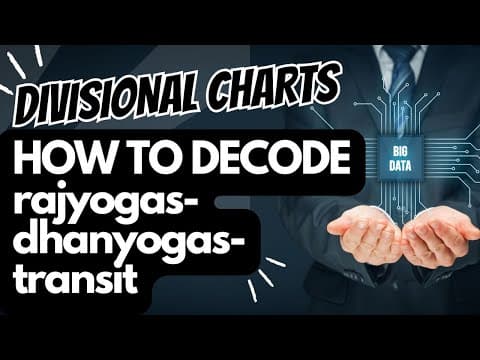Understanding the depths of Vedic astrology requires a comprehensive grasp of Divisional Charts. These charts offer intricate details that the main birth chart might not reveal. In this article, we will delve into the rules of decoding Divisional Charts, focusing on Rajyogas, Dhanyogas, and the role of transits.
Introduction
Divisional Charts in Vedic astrology are like magnifying glasses that zoom into specific areas of life. They provide detailed insights that help astrologers make precise predictions. Whether youre studying the divisional charts in astrology pdf or using a divisional chart calculator, knowing how to interpret these charts is crucial.
The Significance of Divisional Charts
Divisional Charts, also known as Vargas, are subdivisions of the main birth chart (Rashi chart). They offer a microscopic view of different life aspects such as career, marriage, and health. Each chart, like the D9 chart (Navamsa) for marriage or the D10 chart (Dashamsa) for career, focuses on a specific domain.
For those wondering how to read it, its essential to understand that each chart has its own set of rules and significance. Online tools can help, but a deep study is necessary for accurate interpretation.
Approaching Divisional Charts
When you open a Divisional Chart, the first thing to consider is the rising sign in the first house. This sign sets the tone for the entire chart. For example, in the D9 chart, the first house reflects the deeper energies influencing marriage and fortune.
Its also important to assess the relationship between the first house of the Divisional Chart and the main birth chart. If the same sign appears in both, it amplifies the energies associated with that sign.
Analyzing the First House
The first house in any Divisional Chart holds about 80% of the information you need. Heres what to focus on:
Planets in the First House: Identify which planets are placed here. Their influence is significant.
Lord of the First House: Determine where this planet is positioned in the chart. Its placement can indicate the direction of energies related to the charts focus area.
For instance, in the D9 chart, if the first house lord is placed in the fifth house, it suggests positive experiences in marriage. However, if its in the eighth house, it may indicate challenges.
Rajyogas and Dhanyogas in Divisional Charts

Rajyogas and Dhanyogas are auspicious combinations that indicate power, prestige, and wealth. While these yogas are commonly analyzed in the main birth chart, they are equally applicable in Divisional Charts.
Rajyogas: Formed through combinations of angular (Kendra) and trinal (Trikona) houses, they signify authority and success.
Dhanyogas: Involving the second, fifth, ninth, and eleventh houses, they indicate wealth accumulation.
When these yogas appear in a Divisional Chart, they pertain to the specific area represented by that chart. For example, Rajyogas in the D10 chart (Dashamsa) suggest career advancement, while in the D7 chart, they may point to successful progeny.
Understanding Transits in Divisional Charts
Transits play a vital role in timing events. While the main birth chart provides the broader picture, analyzing transits in Divisional Charts offers detailed insights.
During a planets Antardasha (sub-period), its placement in the relevant Divisional Chart can indicate specific outcomes in that period. For example, if youre running the Antardasha of Mars, its position in the D10 chart can reveal career developments.
Practical Application

Lets consider an example:
Main Birth Chart: Your seventh lord is placed in the eleventh house, indicating fulfillment through marriage.
D9 Chart: The first house lord is in the fifth house, suggesting happiness and positive experiences in marriage.
This analysis shows a harmonious connection between the main chart and the Divisional Chart, reinforcing the predictions.
Conclusion
Decoding Divisional Charts requires attention to the first house, the placement of planets, and their relationships with the main birth chart. By understanding the rules and applying them carefully, you can gain profound insights into various life aspects.
Whether youre studying how to calculate divisional charts or exploring which divisional chart for health, remember that each chart offers a unique perspective. Utilize resources like divisional charts in astrology pdf and online calculators, but prioritize deep study and analysis.





































